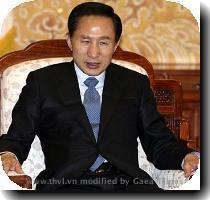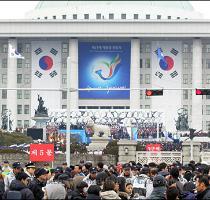SKorea launches psychological warfare over ship sinking; NKorea says its troops brace for war
By Hyung-jin Kim, APTuesday, May 25, 2010
SKorea resumes psychological warfare with NKorea
SEOUL, South Korea — South Korea blared propaganda broadcasts into North Korea on Tuesday after a six-year halt and Pyongyang said its troops were bracing for war as tensions spiked on the divided peninsula over the sinking of a warship.
One Seoul-based monitoring agency reported that North Korea’s leader ordered its 1.2 million-member military to get ready for combat after South Korea blamed the North for a March 26 torpedo strike that sank the warship Cheonan and killed 46 sailors. South Korean officials could not immediately confirm the report.
The South’s restarting of psychological warfare operations — including radio broadcasts into the North and placing loudspeakers at the border to blast out propaganda — were among measures the government announced Monday to punish Pyongyang. The South is also slashing trade and denying permission to North Korean cargo ships to pass through South Korean waters.
A team of international investigators concluded last week that a torpedo from a North Korean submarine tore apart the Cheonan. The sinking was one of the South’s worst military disasters since the 1950-53 Korean War, which ended with an armistice, not a peace treaty.
The North flatly denies involvement and has warned such retaliation would mean war. It has threatened to destroy any propaganda facilities installed at the heavily militarized border.
On Tuesday, the North’s military claimed dozens of South Korean navy ships violated the countries’ disputed western sea border earlier this month and threatened to take “practical” military measures in response, according to the official Korean Central News Agency.
South Korea’s military had no immediate response other than to say that North Korea routinely makes similar accusations.
North Korea is already subject to various U.N.-backed sanctions following earlier nuclear and missile tests. The latest steps announced by Seoul were seen as among the strongest it could take short of military action.
The U.S. has thrown its full support behind South Korea’s moves and they are planning two major military exercises off the Korean peninsula in a display of force intended to deter future aggression by North Korea, the White House said. The U.S. has 28,500 troops in South Korea.
South Korea also wants to bring North Korea before the U.N. Security Council over the sinking. U.N. Secretary-General Ban Ki-moon said Monday he expects the council to take action against North Korea, but China — North Korea’s main ally and a veto-wielding council member — has so far done little but urge calm on all sides.
In Beijing, U.S. Secretary of State Hillary Rodham Clinton said she had “very productive and very detailed” discussions with Chinese officials but could not say if any progress had been made in convincing the Chinese to back U.N. action.
“No one is more concerned about peace and stability in this region as the Chinese,” she told reporters. “We know this is a shared responsibility, and in the days ahead we will work with the international community and our Chinese colleagues to fashion an effective, appropriate response.”
Chinese State Counselor Dai Bingguo, speaking at a news conference with Clinton, called for “relevant parties” to “calmly and properly handle the issue and avoid escalation of tension.”
Russian President Dmitry Medvedev talked with South Korean President Lee Myung-bak on Tuesday and said he “understands well” about South Korea’s moves and will try to give an “appropriate signal” to North Korea over the sinking, according to Lee’s office.
As part of its propaganda offensive, South Korea’s military resumed radio broadcasts airing Western music, news and comparisons between the South and North Korean political and economic situation late Monday, according to the Joint Chiefs of Staff. The military also planned to launch propaganda leaflets by balloon and other methods on Tuesday night to inform North Koreans about the ship sinking.
In coming weeks, South Korea also will install dozens of loudspeakers and towering electronic billboards along the heavily armed land border to send messages urging communist soldiers to defect to the South. The North warned Monday it would fire at any propaganda facilities installed in the Demilitarized Zone.
On Tuesday, North Korean state media cited the powerful National Defense Commission as saying the North’s soldiers and reservists were bracing to launch a “sacred war” against South Korea.
North Korea often issues fiery rhetoric and regularly vows to wage war against South Korea and the U.S. It put its army on high alert following a November sea battle with South Korea near where the Cheonan went down in March. The Koreas also fought bloody maritime skirmishes in the disputed area in 1999 and 2002.
Seoul-based North Korea Intellectuals Solidarity said Tuesday that North Korean leader Kim Jong Il last week ordered his military to get ready for combat.
The group, citing unidentified sources in North Korea, said the order was read by Gen. O Kuk Ryol, a Kim confidant, and broadcast on speakers installed in each house and major public sites throughout the country last Thursday, hours after the multinational report blaming Pyongyang for the sinking was issued in Seoul.
The South Korean military said they had no indication of unusual activity by North Korea’s military.
On Tuesday, the presidential Blue House said officials were reviewing whether South Korea should resume calling North Korea its “main enemy” in formal defense documents for the first time in six years.
In downtown Seoul, about 30 conservative activists burned North Korean flags and ripped up photos of Kim Jong Il.
Associated Press writers Sangwon Yoon in Seoul and Matthew Lee in Beijing, and AP photographer Jin-man Lee in Seoul contributed to this report.
Tags: Accidents, Asia, Beijing, China, Contracts And Orders, East Asia, Greater China, High School Basketball, High School Sports, Lee Myung-bak, North America, North Korea, Pyongyang, Seoul, South Korea, Sports, Transportation, United States



